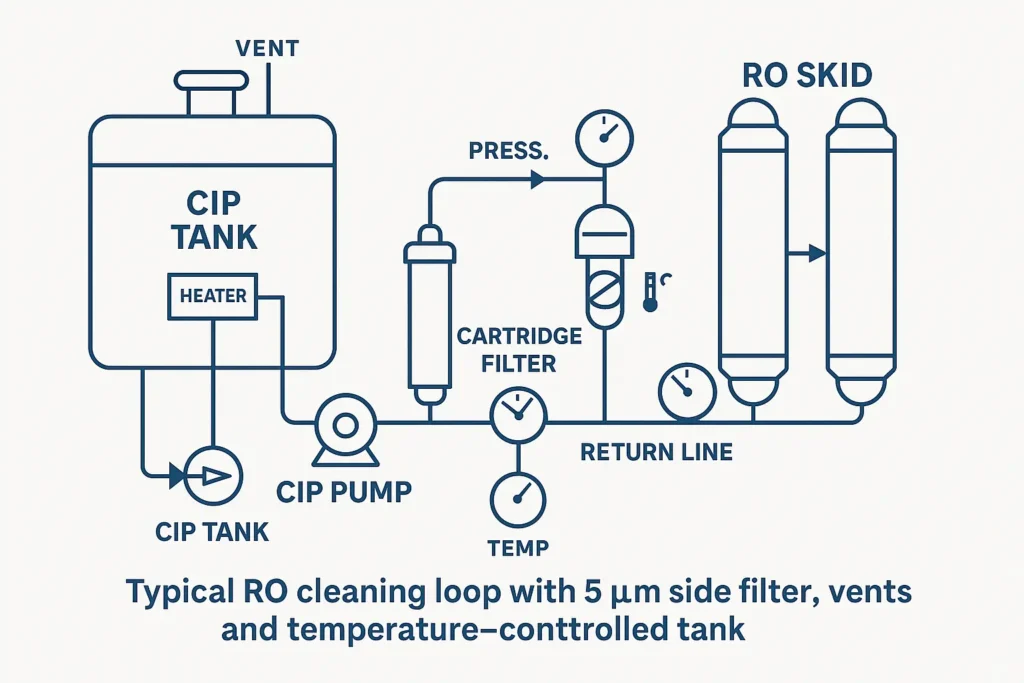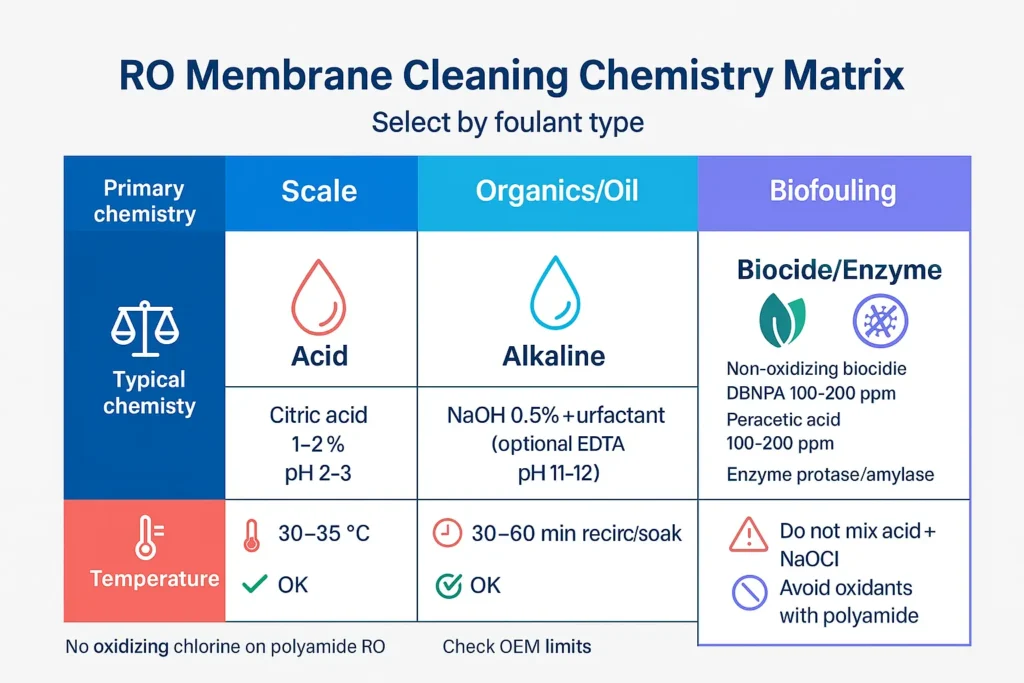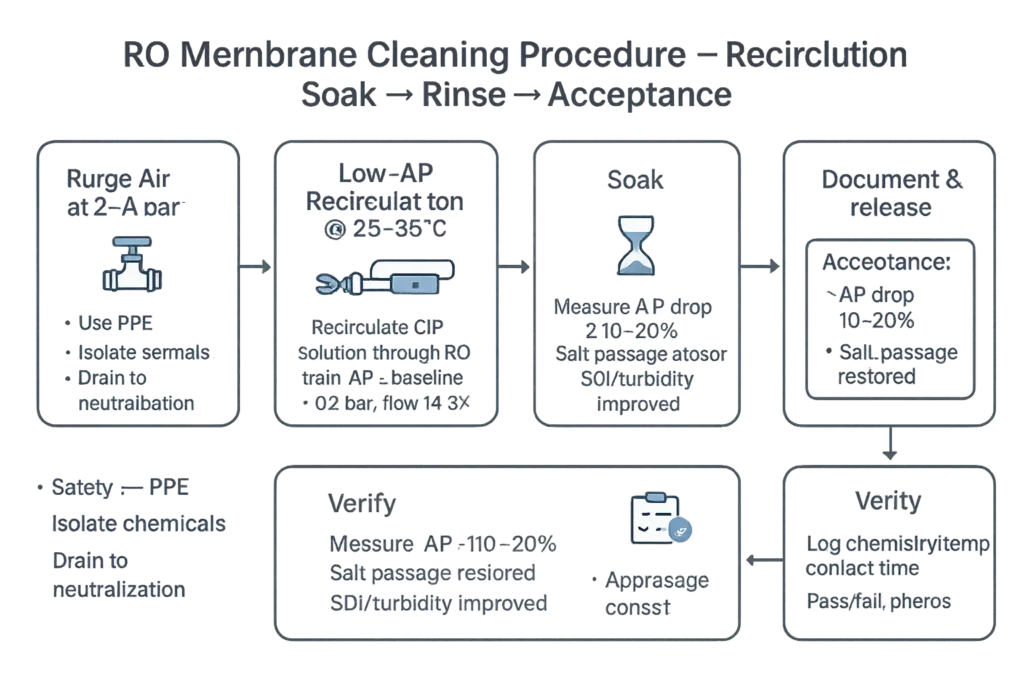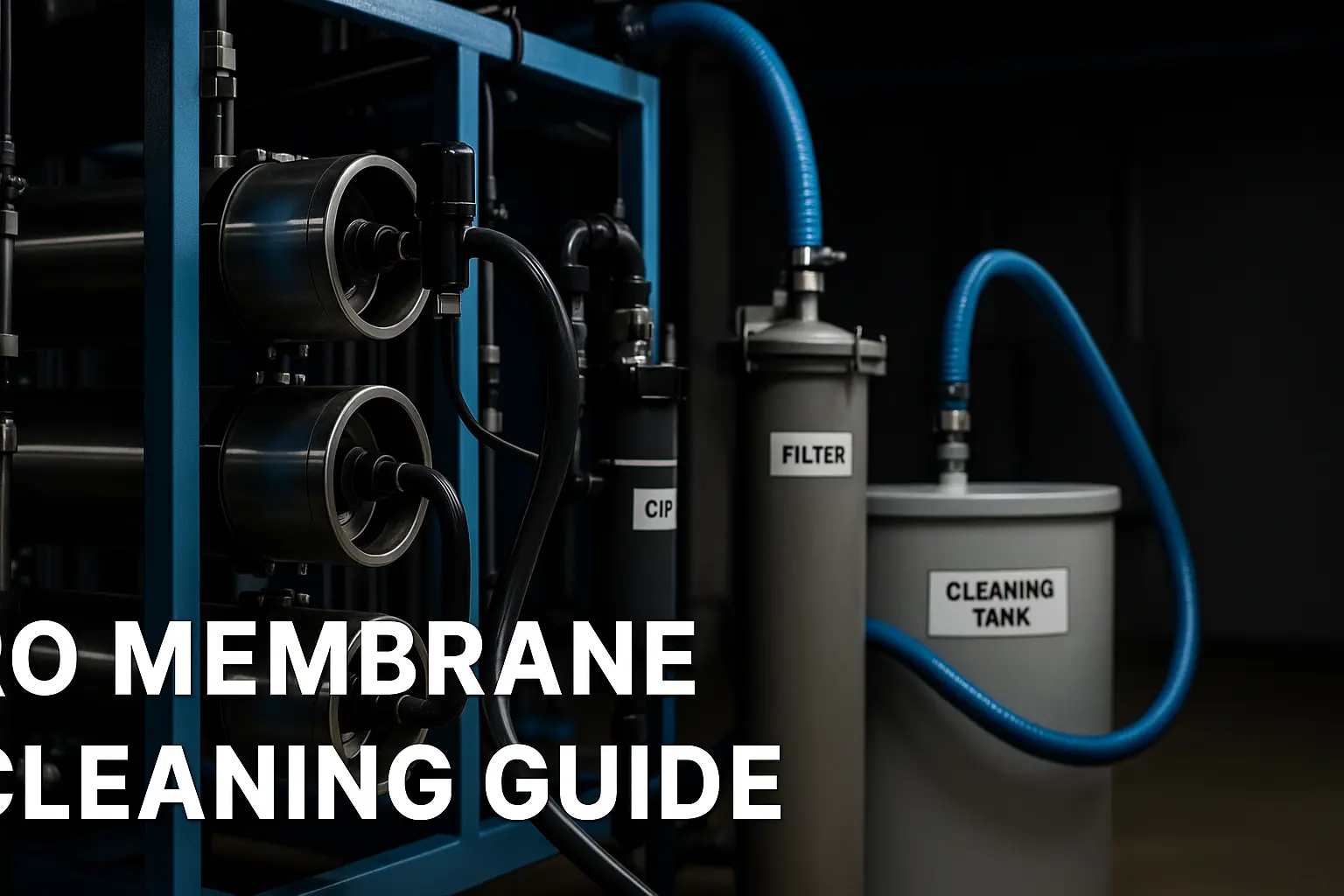Summary: This practical guide explains RO-membraanreiniging—what problems it solves, objective triggers to start a clean, how to choose the right chemistry, and a validated step-by-step SOP. You’ll also get acceptance criteria, troubleshooting, safety and a preventive program to extend membrane life.
Reviewed by Stark Water Process Engineering Team • Last updated: 2025-10-20
1) What RO membrane cleaning solves
Over time, reverse osmosis elements lose performance due to inorganic scale (e.g., CaCO3, CaSO4), organics/colloids, biofoulingen metal oxides. A well-executed cleaning restores normalized flux, lowers differential pressure (ΔP), improves salt rejection and postpones costly membrane replacement.
2) When to clean: objective triggers
| Trigger | Typical threshold | Opmerkingen |
|---|---|---|
| Normalized permeate flow drop | 10-15% below baseline | Use normalized data to remove temp/pressure effects. |
| Salt rejection decline | ≥5% worse than baseline | Monitor product conductivity or salt passage. |
| Feed pressure increase | 15–20% higher at same setpoint | Indicates fouling or scaling. |
| Stage / bank ΔP | > 0.15 MPa (≈ 1.5 bar) rise | Check interstage distribution and air entrapment. |
| Preventive cadence | Every 3-6 maanden in continuous service | Shorten interval for high-foulant feed waters. |
3) Diagnose fouling & pick the chemistry
Match observed symptoms to chemistry. When in doubt, start with alkaline for organics, then acid for scale—rinsing thoroughly between passes.
| Fouling type | Field indicators | Primary chemistry | Setpoints | Compatibility & notes |
|---|---|---|---|---|
| Inorganic scale (CaCO3, CaSO4, Ba/Sr) | High ΔP; efficiency improves during acid recirc | Citrate / HCl (dilute) | pH 2–3, 25–35 °C | Do not exceed OEM temp/pressure; flush thoroughly. |
| Organics / colloids | Tea-colored rinse; SDI high; flux slow to recover | NaOH + surfactant (optionally EDTA) | pH 10–12, 25–35 °C | Rinse to neutral before any acid pass. |
| Biofouling | Slime, odor; rapid ΔP rebound post-start | Alkaline + compatible biocide or enzyme | pH 10–12, per supplier label | No free chlorine on polyamide; verify residual = 0. |
| Metal oxides (Fe/Mn/Al) | Rust-colored rinse; upstream metal carryover | Alkaline + chelant (EDTA) | pH 10–11, 25–35 °C | Improve pretreatment filtration/oxidation. |
| Silica trend | High permeate conductivity not improving with acid | Alkaline with dispersant; manage pH/temperature | Per supplier | Control silica in feed; consider anti-scalant and pH. |
4) RO membrane cleaning procedure (SOP)
4.1 Preparation
- Isolate and lockout/tagout. Verify zero energy (electrical/pneumatic/hydraulic).
- Record baseline: normalized permeate flow, rejection, stage ΔP, temperatures.
- Install a 5 µm side filter in the cleaning loop; confirm vent paths.
4.2 Mix cleaning solution
- Prepare chemical in the CIP tank using RO permeate or DI water.
- Adjust pH en temperatuur to the targets above.
- Size volume to fully fill housings and recirculate with 1–2 tank volumes margin.
4.3 Recirculate at low pressure
- Open vents; purge entrapped air at 2–4 bar; then recirculate at ~1/3 normal ΔP.
- Maintain 30–60 min per stage, keeping crossflow high and permeate valve cracked open if OEM allows.
4.4 Soak
- Soak 1–2 h static. Keep temperature and pH within the window.
- Agitate briefly every 15–20 min to refresh boundary layers.
4.5 Rinse to neutral
- Flush with RO/DI water until discharge pH ≈ 7 and conductivity stabilizes.
- For mixed fouling: alkaline pass → rinse → acid pass → rinse.
4.6 Return to service
- Ramp up slowly while monitoring ΔP and product quality.
- Log post-clean normalized data and compare to acceptance criteria below.
5) Acceptance criteria & documentation
| Metric | Target (post-clean) | Opmerkingen |
|---|---|---|
| Normalized permeate flow | ≥ 90% of baseline | Site target may be 92–95% for critical service. |
| Afwijzing van zout | Near commissioning spec | Check both conductivity and salt passage. |
| Stage / element ΔP | Back within design window | Persistent high ΔP → inspect interconnectors, spacers, air. |
Recordkeeping: keep a signed log (chemicals, pH, temp, times), photos, tag IDs and instrument trends. Attach MSDS and rinse-neutralization records.
6) Troubleshooting if recovery is poor
- Wrong chemistry/sequence: run alkaline then acid; add chelant/surfactant per diagnosis.
- Low crossflow / trapped air: increase recirc, open vents, verify pumps/valves.
- Temperature or pH off-spec: re-heat or re-titrate solution.
- Irreversible fouling or damage: check for oxidation, compaction, or spacer blockage—consider element replacement.
- Rapid re-fouling: fix pretreatment (SDI/NTU), antiscalant dose and dechlorination control.
7) Safety & compliance
- Ik wil volgen lockout/tagout, chemical PPE and eyewash/shower requirements.
- Respect polyamide limits: no free chlorine; follow OEM max temperature/pressure.
- Neutralize and dispose spent solutions per local regulations; document pH and volume.
8) Preventive program to extend membrane life
- Stabilize pretreatment: multimedia/UF as needed; maintain SDI < 3, NTU low.
- Optimize pH and antiscalant; manage silica and LSI/CaSO4 indices.
- Control biogrowth: upstream chlorination → thorough dechlorination (SBS) just before RO.
- Set a cleaning cadence (e.g., quarterly) and trend normalized KPIs weekly.
9) Tools, references & internal links
- RO system commissioning checklist
- RO membrane installation diagram
- Calculators (LSI, OPEX, chlorine/SBS)
- Water Quality Association (WQA) guidance
- ISPE cleaning & sanitization resources
10) Request a quote / speak to an engineer
Share your normalized data and a recent water analysis—we’ll confirm the RO-membraanreiniging recipe, size your CIP skid and propose improvements to pretreatment and controls.




